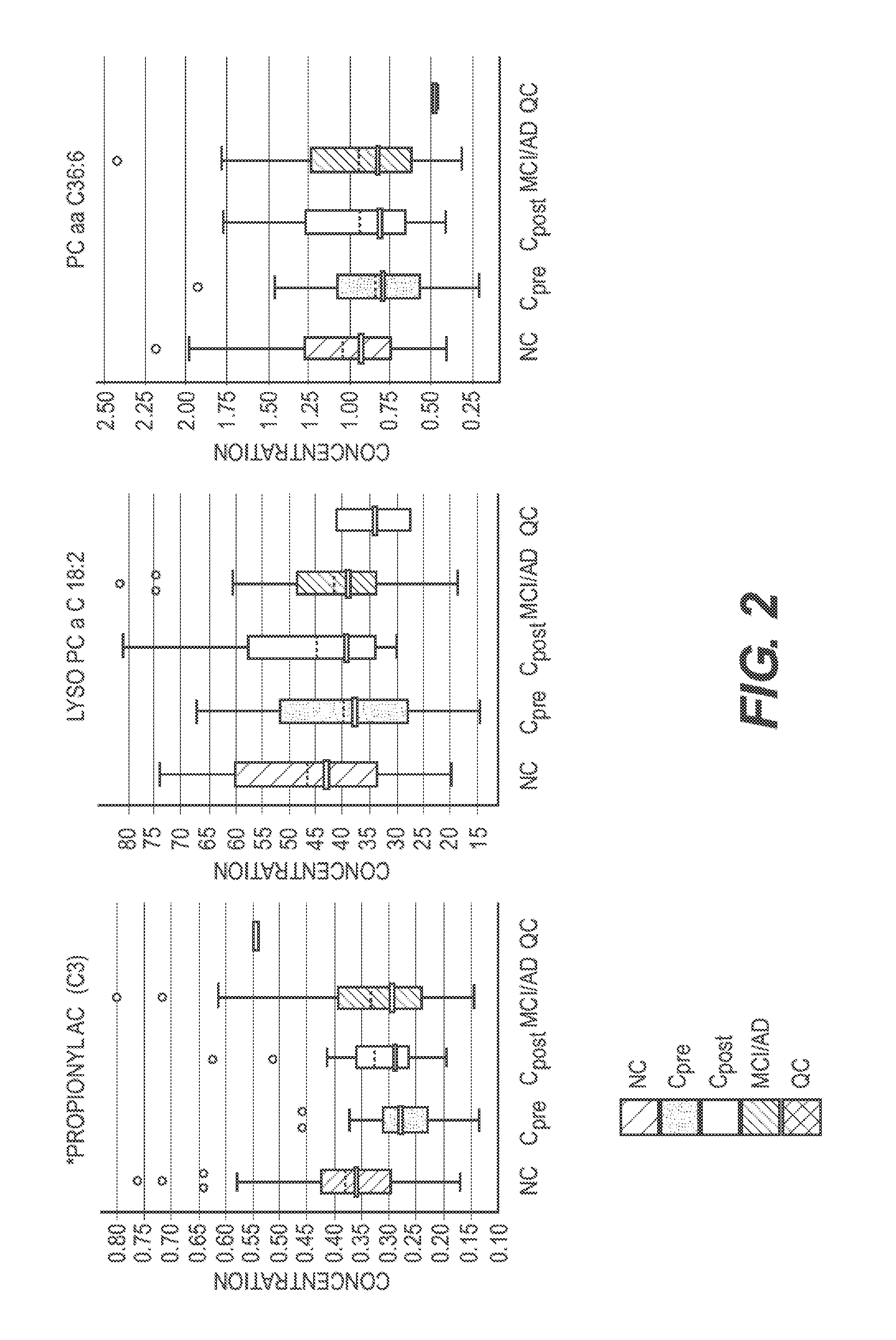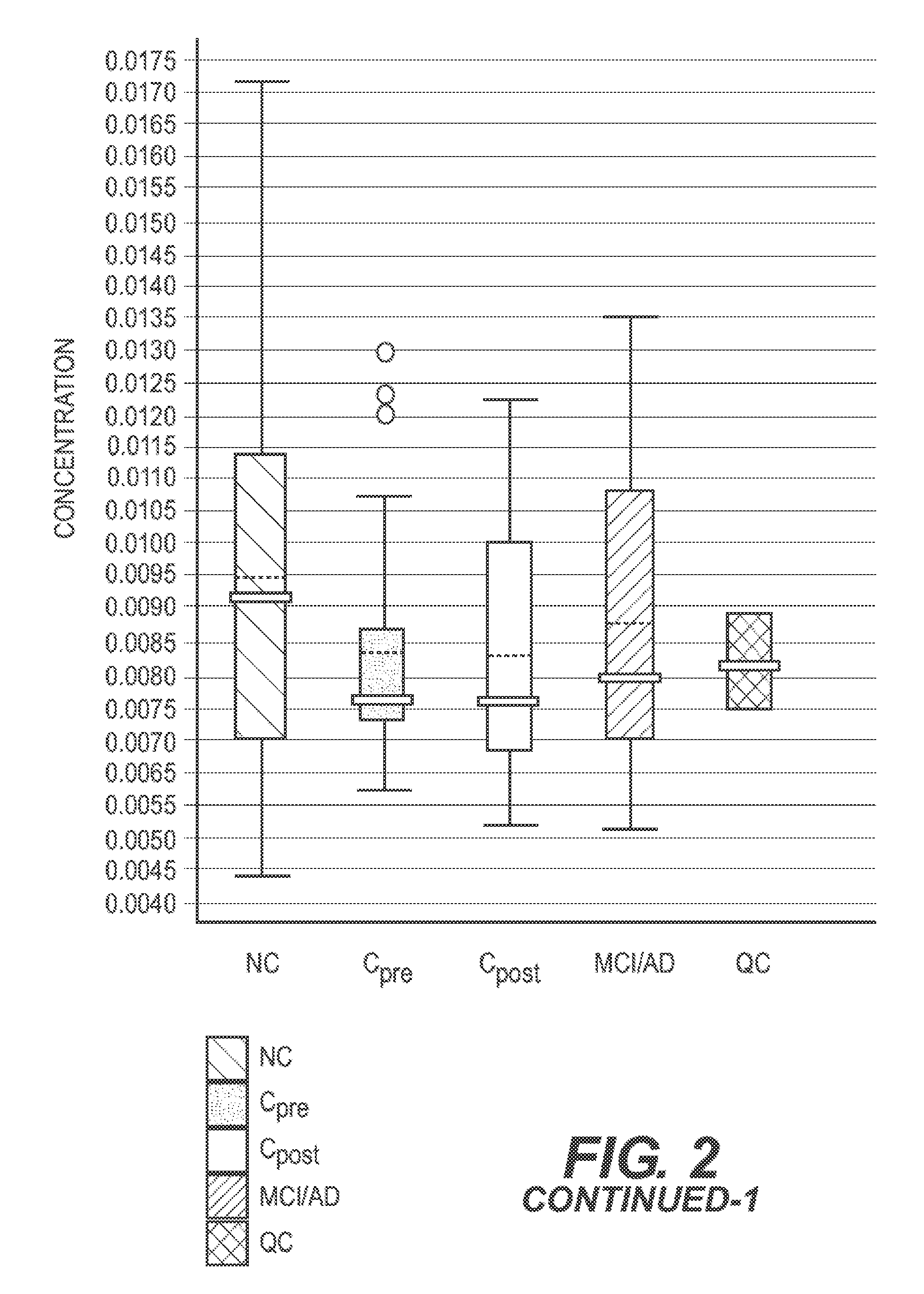Metabolic and Genetic Biomarkers for Memory Loss
a genetic biomarker and metabolic technology, applied in the field of metabolic and genetic biomarkers for memory loss, can solve the problems of inability to slow the disease progression, no cure, and current blood-based biomarkers cannot detect incipient dementia with the required sensitivity and specificity, and achieve the effect of reducing the subject's lipidomic profil
- Summary
- Abstract
- Description
- Claims
- Application Information
AI Technical Summary
Benefits of technology
Problems solved by technology
Method used
Image
Examples
example 1
Neurocognitive Methods
[0058]A total of 525 volunteers participated in this study as part of the Rochester / Orange County Aging Study (R / OCAS), an ongoing natural history study of cognition in community-dwelling older adults. Briefly, participants were followed with yearly cognitive assessments and blood samples were collected following an overnight fast and withholding of all medications. At baseline and each yearly visit, participants completed assessments in such as activities in daily living, memory complaints, signs and symptoms of depression, and were administered a detailed cognitive assessment.
[0059]For this study, data from the cognitive tests were used to classify participants into groups for biomarker discovery. Standardized scores (Z-scores) were derived for each participant on each cognitive test and the composite Z-scores were computed for five cognitive domains (attention, executive, language, memory, visuoperceptual) (Table 4).
TABLE 4Lan-Visuoper-AttentionExecutiveguag...
example 2
Lipidomics Reagents
[0067]LC / MS-grade acetonitrile (ACN), Isopropanol (IPA), water and methanol were purchased from Fisher Scientific (New Jersey, USA). High purity formic acid (99%) was purchased from Thermo-Scientific (Rockford, Ill.). Debrisoquine, 4-Nitrobenzoic acid (4-NBA), Pro-Asn, Glycoursodeoxycholic acid, Malic acid, were purchased from Sigma (St. Louis, Mo., USA). All lipid standards including 14:0 LPA, 17:0 Ceramide, 12:0 LPC, 18:0 Lyso PI and PC(22:6 / 0:0) were procured from Avanti Polar Lipids Inc. (USA).
[0068]Metabolite Extraction
[0069]Briefly, the plasma samples were thawed on ice and vortexed. For metabolite extraction, 25 μL of plasma sample was mixed with 175 μL of extraction buffer (25% acetonitrile in 40% methanol and 35% water) containing internal standards [10 μL of debrisoquine (1 mg / mL), 50A of 4, nitro-benzoic acid (1 mg / mL), 27.3 μl of Ceramide (1 mg / mL) and 2.5 μL of LPA (lysophosphatidic acid) (4 mg / mL) in 10 mL). The samples were incubated on ice for 10 m...
example 3
Sample Extraction Methods for Gene Expression Analysis
[0091]When blood was drawn from the subject for lipidomic analysis according to Example 2 above, blood was also drawn and placed in a PAXgene® blood tube (Qiagen). Samples were then processed according to the manufacturer's suggested protocol for RNA extraction.
[0092]Messenger RNA (mRNA) sequencing was performed using an Illumina High Seq™ sequencing platform. In brief, after specimen thawing, globin mRNA was depleted from the total RNA samples using the GLOBINclear-Human Kit™ (# AM1980, Life Technologies, Grand Island, N.Y., USA), as described by the vendor. A total of 1.25 μg of RNA isolated from whole blood was then combined with biotinylated capture oligonucleotides complementary to globin mRNAs. The mixture was incubated at 50° C. for 15 minutes to allow duplex formation. Streptavidin magnetic beads were added to each specimen, and the resulting mixture was incubated for an additional 30 minutes at 50° C. to allow binding of...
PUM
| Property | Measurement | Unit |
|---|---|---|
| flow rate | aaaaa | aaaaa |
| flow rate | aaaaa | aaaaa |
| voltage | aaaaa | aaaaa |
Abstract
Description
Claims
Application Information
 Login to View More
Login to View More - R&D
- Intellectual Property
- Life Sciences
- Materials
- Tech Scout
- Unparalleled Data Quality
- Higher Quality Content
- 60% Fewer Hallucinations
Browse by: Latest US Patents, China's latest patents, Technical Efficacy Thesaurus, Application Domain, Technology Topic, Popular Technical Reports.
© 2025 PatSnap. All rights reserved.Legal|Privacy policy|Modern Slavery Act Transparency Statement|Sitemap|About US| Contact US: help@patsnap.com



